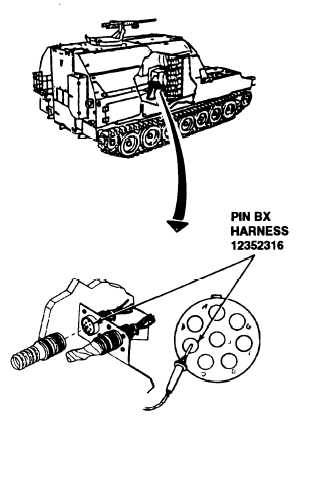TM 9-2350-287-20-1
2-19. TROUBLESHOOTING CHART (continued).
o. PERSONNEL VENTILATION BLOWER (continued).
(4) PERSONNEL VENTILATION BLOWER OPER-
ATES, BUT DOES NOT COME ON AUTOMATI-
CALLY IN EXHAUST MODE DURING AFES
TEST.
Initial Setup:
Tools/Test Equipment:
l Digital multimeter (DMM) (Item 13, Appendix 1)
l General mechanic’s tool kit (Item 24,
Appendix 1)
Materials/Parts:
l LockWashers (4) (Item 196, Appendix H)
Equipment Conditions:
l Crew AFES anti-recoil plugs installed
(para 21-4 and 21-5).
• Engine AFES anti-recoil plugs installed
(para 21-4).
l Engine AFES bottle safety pins installed
(para 21-4).
• Crew AFES bottle safety pins installed (para 21-5)
l Engine AFES T/A panel maintenance switch
turned to vertical position (refer to
TM 9-2350-287-10).
l Crew AFES T/A panel maintenance switch
turned to vertical position (refer to
TM 9-2350-287-10).
l Left projectile rack assembly moved to rear of
vehicle (refer toTM 9-2350-287-10).
l MASTER switch set to OFF (refer to
TM 9-2350-287-10).
Ventilation and Automatic Fire
Extinguishing System (AFES)
electrical systems are inter-
connected.
NOTE
l Instead of using multi meter
for voltage
check, STE/lCE
troubleshooting,
INDIVIDUAL
BATTERY VOLTAGE TEST-TEST
89 maybe performed.
l Instead of using multi meter
for continuity check, STE/lCE
troubleshooting, TEST 91 may
be performed.
l Ensure all electrical connectors are
securely fastened. A loose connector
could cause incorrect fault indi-
cat ions.
A. 1. Disconnect PERSONNEL VENTILATOR
BLOWER wiring harness 12351461 from
AFES wiring harness 12352316 bracket-
mounted connector.
2. Connect red lead of multimeter to pin BX of
wiring harness 12352316 and black lead of
multimeter to ground.
Continued on next page
2-262

